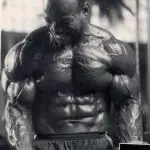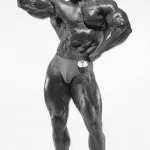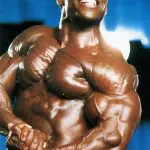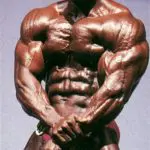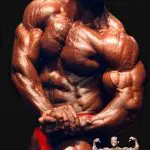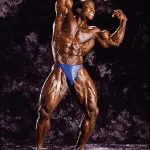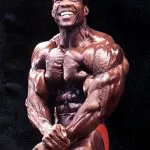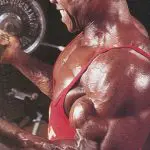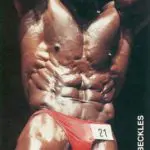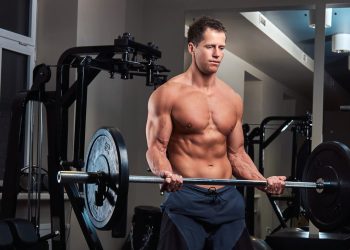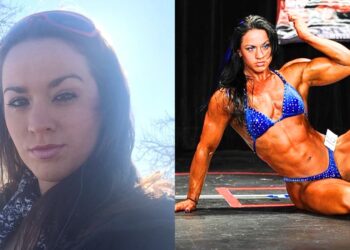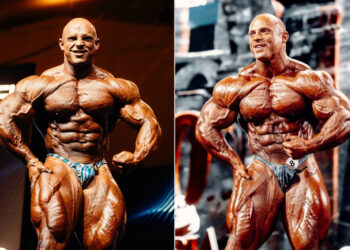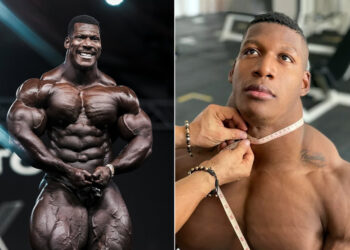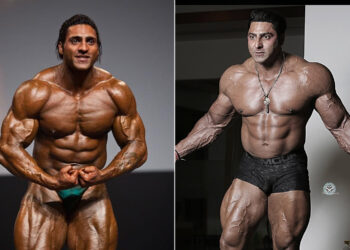Albert Beckles is a retired British bodybuilder. He competed professionally for nearly 30 years and won several bodybuilding shows during a legendary career while placing high in several others. This article explores his biography, competition history, workout routine, diet, and statistics.
Albert Beckles
Born: July 14, 1930
Birthplace: Bridgetown, BARBADOS
Residence: North Hollywood, California, USA
Nickname: Al Peak Beckle’s
Height: 5′ 6″ (170 cm)
Weight: 218 lbs (99 kg)
Neck: 16,5″ (42 cm)
Waist: 31″ (79 cm)
Thigh: 25″ (64 cm)
Calf: 16,5″ (42 cm)
Arms: 19″ (48 cm)
Chest: 48,5″ (123 cm)
Albert Beckles Biography
Born in Barbados, he emigrated to London, where in the mid-’60s he began winning regional British titles, before taking the 1969 and 1970 NABBA Mr. Britain titles (which were awarded in 1970 and ’71). Later in ’71, he joined the IFBB, earning the overall at that year’s IFBB Mr. Universe. His high-peaked biceps and crisp overall appearance have been his trademark throughout his career.
Level Up Your Fitness: Join our 💪 strong community in Fitness Volt Newsletter. Get daily inspiration, expert-backed workouts, nutrition tips, the latest in strength sports, and the support you need to reach your goals. Subscribe for free!
Al has been one of the most active participants ever suiting up to pose down in more than 100 different contests. In 1982, he took the Big Apple’s big enchilada, winning the Night of Champions. Beckle’s record-setting 13 forays into the IFBB Mr. Olympia (Shawn Ray is nearest with 12) have yielded six placings among the top five, including coming second in 1985 to Lee Haney at twice Haney’s age.
Beckle’s most recent win was a decade ago when he sent the other competitors at the 1991 Niagara Falls Pro Invitational tumbling to the rocks below. His retirement following the Chicago Pro Invitational on May 9, 1992, ended a competitive career spanning five decades. Never known as one who bickers, Beckle’s is forever the British gentleman.
First mistakenly introduced to British readers of Health & Strength in January 1957 as “Al Bickers”, it is now his age that causes a little confusion: Al asserts he was born in 1930, but some early reports suggested 1938 as his birth year. Whatever his age, Albert Beckles has been in phenomenal shape for five decades.
Life after retirement
Bodybuilding was Albert Beckles’ passion and he continued to train hard after retiring from competition. Beckles has been active in the gym until now. The veteran bodybuilder left the bodybuilding world in awe when he, at 92, hit the gym regularly and boasted a great deal of muscle mass. His youthful enthusiasm and fitness level have earned him the moniker ‘The Fountain of Youth’.
His incredible journey and healthy life have set a positive example for bodybuilders to follow. In a world where bodybuilding is now associated with steroid abuse and an unhealthy obsession with size, Beckles has proven that the sport can be pursued without inflicting long-term physical damage on the body.
Competition History
- 1965 NABBA Mr. Britain – 5th place
- 1965 NABBA Mr. Universe – 3rd place
- 1966 NABBA Mr. Universe, Medium – 6th place
- 1967 NABBA Mr. Britain – 3rd place
- 1968 NABBA Mr. Britain – 2nd place
- 1969 NABBA Mr. Britain – 2nd place
- 1969 IFBB Mr. World, Medium – 2nd place
- 1969 NABBA Mr. Universe, Medium – 3rd place
- 1970 NABBA Mr. Britain – 1st place
- 1970 Mr. Europe – 1st place
- 1970 Mr. Europe, Medium – 1st place
- 1970 NABBA Mr. Universe, Medium – 2nd place
- 1971 NABBA Mr. Britain – 1st place
- 1971 AAU Mr. World – 1st place
- 1971 IFBB Mr. Universe, Medium – 1st place and overall winner
- 1971 NABBA Mr. Universe, Medium – 1st place and overall winner
- 1973 IFBB Mr. Europe, Medium – 1st place and overall winner
- 1973 IFBB Mr. Universe, Medium – 1st place
- 1975 IFBB Mr. Olympia, Lightweight – 3rd place
- 1975 IFBB Mr. Universe, Medium – 2nd place
- 1977 IFBB Mr. Olympia, Short – 4th place and 7th place overall
- 1978 IFBB Mr. Olympia, Lightweight – 8th place
- 1979 IFBB Best in the WOrld, Professional – 3rd place
- 1979 IFBB Grand Prix Pennsylvania – 3rd place
- 1979 IFBB Mr. Olympia, Lightweight – 7th place
- 1979 IFBB World Pro Championships – 2nd place
- 1980 IFBB Mr. Universe Pro – 4th place
- 1980 IFBB World Pro Championships – 4th place
- 1981 IFBB Canada Pro Cup – 2nd place
- 1981 IFBB Grand Prix Belgium – 2nd place
- 1981 IFBB Grand Prix California – 4th place
- 1981 IFBB Grand Prix Louisiana – 2nd place
- 1981 IFBB Grand Prix Massachusetts – 2nd place
- 1981 IFBB Grand Prix New England – 1st place
- 1981 IFBB Grand Prix New York – 2nd place
- 1981 IFBB Grand Prix Wales – 3rd place
- 1981 IFBB Grand Prix World Cup – 6th place
- 1982 IFBB Grand Prix Belgium – 2nd place
- 1982 IFBB Grand Prix Sweden – 4th place
- 1982 IFBB Night of Champions – 1st place
- 1982 IFBB Mr. Olympia – 5th place
- 1982 IFBB World Pro Championships – 1st place
- 1983 IFBB Grand Prix England – 5th place
- 1983 IFBB Grand Prix Las Vegas – 3rd place
- 1983 IFBB Grand Prix Portland – 4th place
- 1983 IFBB Grand Prix Sweden – 5th place
- 1983 IFBB Grand Prix Switzerland – 5th place
- 1983 IFBB Night of Champions – 3rd place
- 1983 IFBB Mr. Olympia – 7th place
- 1984 IFBB Canada Pro Cup – 1st place
- 1984 IFBB Mr. Olympia – 4th place
- 1984 IFBB Grand Prix – 1st place
- 1984 IFBB World Pro Championships – 1st place
- 1985 IFBB Night of Champions – 1st place
- 1985 IFBB Mr. Olympia – 2nd place
- 1986 IFBB Mr. Olympia – 4th place
- 1987 IFBB Grand Prix France – 4th place
- 1987 IFBB Grand Prix Germany – 4th place
- 1987 IFBB Grand Prix Germany (2) – 6th place
- 1987 IFBB Mr. Olympia – 7th place
- 1987 IFBB World Pro Championships – 3rd place
- 1988 IFBB Chicago Pro Invitational – 4th place
- 1988 IFBB Grand Prix England – 7th place
- 1988 IFBB Grand Prix France – 11th place
- 1988 IFBB Grand Prix Germany – 8th place
- 1988 Grand Prix Italy – 8th place
- 1988 IFBB Grand Prix Spain – 7th place
- 1988 IFBB Grand Prix Spain (2) – 8th place
- 1988 IFBB Grand Prix Spain – 7th place
- 1988 IFBB Night of Champions – 5th place
- 1988 IFBB Mr. Olympia – 15th place
- 1988 IFBB World Pro Championships – 10th place
- 1989 IFBB Arnold Classic – 7th place
- 1989 IFBB Grand Prix England – 9th place
- 1989 IFBB Grand Prix Finland – 9th place
- 1989 IFBB Grand Prix France – 9th place
- 1989 IFBB Grand Prix Holland – 11th place
- 1989 IFBB Grand Prix Melbourne – 4th place
- 1989 IFBB Grand Prix Spain – 10th place
- 1989 IFBB Grand Prix Spain (2) – 10th place
- 1989 IFBB Grand Prix Sweden – 9th place
- 1989 IFBB Grand Prix US Pro – 4th place
- 1989 IFBB Night of Champions – 8th place
- 1989 IFBB Mr. Olympia – 15th place
- 1989 IFBB World Pro Championships – 4th place
- 1990 IFBB Arnold Classic – 9th place
- 1990 IFBB Houston Pro Invitational – 11th place
- 1990 IFBB Niagara Falls Pro Invitational – 12th place
- 1990 IFBB Night of Champions – Did not place
- 1991 IFBB Grand Prix Denmark – 7th place
- 1991 IFBB Grand Prix England – 7th place
- 1991 IFBB Grand Prix Finland – 9th place
- 1991 IFBB Grand Prix Italy – 8th place
- 1991 IFBB Grand Prix Spain – 9th place
- 1991 IFBB Grand Prix Switzerland – 8th place
- 1991 IFBB Niagara Falls Pro Invitational – 1st place
- 1991 IFBB Night of Champions – 7th place
- 1991 IFBB Mr. Olympia – Did not place
- 1991 IFBB Pittsburg Pro Invitational – 12th place
- 1991 IFBB San Jose Pro Invitational – 5th place
- 1992 IFBB Chicago Pro Invitational – 16th place
- 1992 IFBB Niagara Falls Pro Invitational – 8th place
Albert Beckles Workout
Albert Beckles’ workout routine and bodybuilding lifestyle best represented the knowledge available to the bodybuilding community at the time. All in all, there was no place for weakness and the veteran bodybuilder believed that the harder you train and force the body to get stronger, the more the chances of you getting the physique you desired.
Beckles was closely associated with legendary bodybuilder Bertil Fox. It was Fox who guided him initially through planning his training routine and helped him come up with his style of training. But apart from Fox, Lou Ferrigno and Lee Haney also contributed significantly to Beckles’ training journey.
There was no fluctuation in intensity based on the stage of training. Beckles trained twice a day, seven days a week during the off-season. The same pattern followed to the competition date.
Beckles increased the training intensity with common yet effective methods like drop sets and supersets. He made most of his gains using effective compound movements that helped build muscle and functional strength. But there was room for isolation exercises to target specific muscles to bring them to par with the more developed muscles and also to get more definition and detail.
While most bodybuilders of his era trained with heavy weights, Beckles used lighter weights and focused more on contracting and stretching the muscles with proper techniques. He was a big believer in performing slow reps to keep the muscles under tension for a longer duration and the results could be seen in the physique he was able to build.
Level Up Your Fitness: Join our 💪 strong community in Fitness Volt Newsletter. Get daily inspiration, expert-backed workouts, nutrition tips, the latest in strength sports, and the support you need to reach your goals. Subscribe for free!
But Beckles compensated with volume what he sacrificed in terms of weight. The high volume increased the training intensity and helped him build endurance and muscle mass.
Cardio was an important component of Beckles’ training program and he relied on high-intensity cardio exercises to burn fat, improve cardiovascular function, and add variety to the workout regimen.
Albert Beckles employed different rep ranges, weights, and intensity-building criteria for different muscle groups. For instance, he relied on heavy weights and high training volume to build the lower body muscles. On the contrary, he used moderate weights but high volume for smaller muscles like arms to get the pump.
For the chest and back, the veteran bodybuilder mostly used primary compound movements like bench presses and barbell rows. These muscles work several muscles and joints in conjunction with each other and help build not just muscle mass but also functional strength.
A typical training week in Albert Beckles’ routine looked like this:
Day 1 – Chest and Legs
Morning – Chest
- Incline Dumbbell Press – 4 to 5 sets of 12 to 15 reps
- Parallel Bar Dips – 4 to 5 sets of 12 to 15 reps
- Barbell Bench Press – 4 to 5 sets of 12 to 15 reps
- Incline Dumbbell Flyes – 4 to 5 sets of 12 to 15 reps
- Close Grip Barbell Bench Press – 4 to 5 sets of 12 to 15 reps
- Pec Deck Flyes – 4 to 5 sets of 12 to 15 reps
Evening – Legs
- Barbell Squats – 4 to 5 sets of 12 to 15 reps
- Hack Squats – 4 to 5 sets of 12 to 15 reps
- Leg Extensions – 4 to 5 sets of 12 to 15 reps
- Standing Heel Raises – 4 to 5 sets of 12 to 15 reps or more
- Seated Calf Raises – 4 to 5 sets of 12 to 15 reps or more
Day 2 – Shoulders and Legs
Morning – Shoulders
- Seated Barbell Shoulder Press – 4 to 5 sets of 12 to 15 reps
- Superset – Dumbbell Lateral Raises and Seated Smith Machine Overhead Press – 4 to 5 sets of 12 to 15 reps
- Barbell Upright Rows – 4 to 5 sets of 12 to 15 reps
- Cable Lateral Raises – 4 to 5 sets of 12 to 15 reps
- Barbell Shrugs – 4 to 5 sets of 12 to 15 reps
Evening – Legs
- Barbell Squats – 4 to 5 sets of 12 to 15 reps
- Leg Curls – 4 to 5 sets of 12 to 15 reps
- Leg Extensions – 4 to 5 sets of 12 to 15 reps
- Standing Heel Raises – 4 to 5 sets of 12 to 15 reps
- Seated Calf Raises – 4 to 5 sets of 12 to 15 reps or more
- Donkey Calf Raises – 4 to 5 sets of 12 to 15 reps or more
Day 3 – Back and Legs
Morning – Back
- Wide Grip Pull-Ups – 4 to 5 sets of 12 to 15 reps
- Seated Wide Grip Cable Rows – 4 to 5 sets of 12 to 15 reps
- Close Grip Cable Pulldown – 4 to 5 sets of 12 to 15 reps
- T-Bar Rows – 4 to 5 sets of 12 to 15 reps
- Barbell Rows – 4 to 5 sets of 12 to 15 reps
- Barbell Pullovers – 4 to 5 sets of 12 to 15 reps
Evening – Legs
- Barbell Squats – 4 to 5 sets of 12 to 15 reps
- Hack Squats – 4 to 5 sets of 12 to 15 reps
- Leg Extensions – 4 to 5 sets of 12 to 15 reps
- Standing Heel Raises – 4 to 5 sets of 12 to 15 reps
- Seated Calf Raises – 4 to 5 sets of 12 to 15 reps
Days 4, 5 and 6
- Same as the first three days
Day 7
- Start over
Albert Beckles Diet
Like training, Albert Beckles had a disciplined approach to dieting which made sure that his physique could stay in peak condition well past his physical prime. He followed a high-protein diet and got most of his protein through high-quality sources like chicken, tuna, other fish, and, of course, eggs.
Beckles was a huge believer in the benefits of eggs for bodybuilding as well as overall health. But besides eggs and animal-based protein sources, he ate healthy portions of lentils, legumes, and leafy green vegetables to get fiber and micronutrients. Milk and other dairy products were not out of bounds for the veteran bodybuilder either. However, he is known to have consumed red meats in relatively low quantities.
Besides this whole food diet, Beckles used supplements to meet the nutritional requirements of his massive and sculpted physique.
To Conclude…
Albert Beckles personifies long-term health and performance longevity in a sport that is inherently taxing on the body. The original intent of bodybuilding was to reward the individuals who represent the best in terms of health, performance, and aesthetics. However, many people feel that the sport of bodybuilding has diverted from the original objectives and started rewarding massive physiques above all else. Albert Beckles is a perfect example of what a bodybuilder needs to represent.

